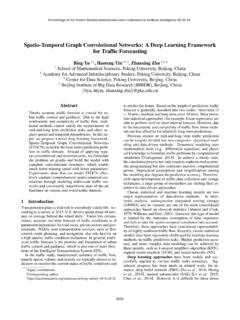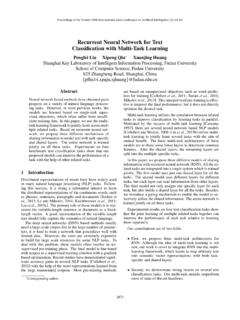Transcription of Neural Networks and Statistical Models
1 Neural Networks and Statistical Models Proceedings of the Nineteenth Annual SAS Users Group International Conference, April, 1994. Warren S. Sarle, SAS Institute Inc., Cary, NC, USA. Abstract intelligent in the usual sense of the word. Artificial Neural Networks learn in much the same way that many Statistical There has been much publicity about the ability of artificial Neural algorithms do estimation, but usually much more slowly than Networks to learn and generalize. In fact, the most commonly Statistical algorithms. If artificial Neural Networks are intelligent, used artificial Neural Networks , called multilayer perceptrons, are then many Statistical methods must also be considered intelligent.
2 Nothing more than nonlinear regression and discriminant Models Few published works provide much insight into the relationship that can be implemented with standard Statistical software. This between statistics and Neural Networks Ripley (1993) is probably paper explains what Neural Networks are, translates Neural network the best account to date. Weiss and Kulikowski (1991) provide a jargon into Statistical jargon, and shows the relationships between good elementary discussion of a variety of classification methods Neural Networks and Statistical Models such as generalized linear including Statistical and Neural methods. For those interested in Models , maximum redundancy analysis, projection pursuit, and more than the Statistical aspects of Neural Networks , Hinton (1992).
3 Cluster analysis. offers a readable introduction without the inflated claims common in popular accounts. The best book on Neural Networks is Hertz, Krogh, and Palmer (1991), which can be consulted regarding introduction most Neural net issues for which explicit citations are not given in this paper. Hertz et al. also cover nonstatistical Networks such as Neural Networks are a wide class of flexible nonlinear regression Hopfield Networks and Boltzmann machines. Masters (1993) is a and discriminant Models , data reduction Models , and nonlinear good source of practical advice on Neural Networks . White (1992). dynamical systems. They consist of an often large number of contains reprints of many useful articles on Neural Networks and neurons, simple linear or nonlinear computing elements, statistics at an advanced level.
4 Interconnected in often complex ways and often organized into layers. Artificial Neural Networks are used in three main ways: Models and Algorithms as Models of biological nervous systems and intelligence . as real-time adaptive signal processors or controllers imple- When Neural Networks (henceforth NNs, with the adjective ar- mented in hardware for applications such as robots tificial implied) are used for data analysis, it is important to distinguish between NN Models and NN algorithms. as data analytic methods Many NN Models are similar or identical to popular statis- This paper is concerned with artificial Neural Networks for data tical techniques such as generalized linear Models , polynomial analysis.
5 Regression, nonparametric regression and discriminant analysis, The development of artificial Neural Networks arose from the projection pursuit regression, principal components, and cluster attempt to simulate biological nervous systems by combining analysis, especially where the emphasis is on prediction of com- many simple computing elements (neurons) into a highly inter- plicated phenomena rather than on explanation. These NN Models connected system and hoping that complex phenomena such as can be very useful. There are also a few NN Models , such as coun- intelligence would emerge as the result of self-organization or terpropagation, learning vector quantization, and self-organizing learning.
6 The alleged potential intelligence of Neural Networks maps, that have no precise Statistical equivalent but may be useful led to much research in implementing artificial Neural Networks for data analysis. in hardware such as VLSI chips. The literature remains con- Many NN researchers are engineers, physicists, neurophysi- fused as to whether artificial Neural Networks are supposed to ologists, psychologists, or computer scientists who know little be realistic biological Models or practical machines. For data about statistics and nonlinear optimization. NN researchers rou- analysis, biological plausibility and hardware implementability tinely reinvent methods that have been known in the Statistical or are irrelevant.
7 Mathematical literature for decades or centuries, but they often The alleged intelligence of artificial Neural Networks is a matter fail to understand how these methods work ( , Specht 1991). of dispute. Artificial Neural Networks rarely have more than a The common implementations of NNs are based on biological few hundred or a few thousand neurons, while the human brain or engineering criteria, such as how easy it is to fit the net on a has about one hundred billion neurons. Networks comparable to chip, rather than on well-established Statistical and optimization a human brain in complexity are still far beyond the capacity of criteria.
8 The fastest, most highly parallel computers in existence. Artificial Standard NN learning algorithms are inefficient because they Neural Networks , like many Statistical methods, are capable of are designed to be implemented on massively parallel computers processing vast amounts of data and making predictions that but are, in fact, usually implemented on common serial computers are sometimes surprisingly accurate; this does not make them such as ordinary PCs. On a serial computer, NNs can be trained 1. more efficiently by standard numerical optimization algorithms Boxes represent values computed as a function of one or such as those used for nonlinear regression.
9 Nonlinear regression more arguments. The symbol inside the box indicates the algorithms can fit most NN Models orders of magnitude faster type of function. Most boxes also have a corresponding than the standard NN algorithms. parameter called a bias. Another reason for the inefficiency of NN algorithms is that Arrows indicate that the source of the arrow is an argument they are often designed for situations where the data are not of the function computed at the destination of the arrow. stored, but each observation is available transiently in a real-time Each arrow usually has a corresponding weight or parameter environment. Transient data are inappropriate for most types of to be estimated.
10 Statistical analysis. In Statistical applications, the data are usually Two long parallel lines indicate that the values at each end stored and are repeatedly accessible, so Statistical algorithms can are to be fitted by least squares, maximum likelihood, or be faster and more stable than NN algorithms. some other estimation criterion. Hence, for most practical data analysis applications, the usual NN algorithms are not useful. You do not need to know anything Input Output Target about NN training methods such as backpropagation to use NNs.. Jargon Although many NN Models are similar or identical to well-known Independent Predicted Dependent Statistical Models , the terminology in the NN literature is quite Variable Value Variable different from that in statistics.





![arXiv:1910.03151v4 [cs.CV] 7 Apr 2020](/cache/preview/f/4/1/e/d/d/8/f/thumb-f41edd8febe3e5c0bf37eae38812e8b7.jpg)



